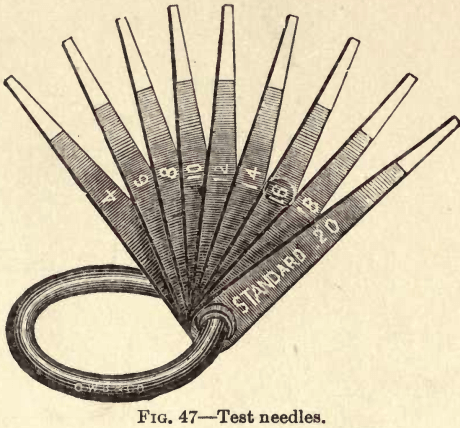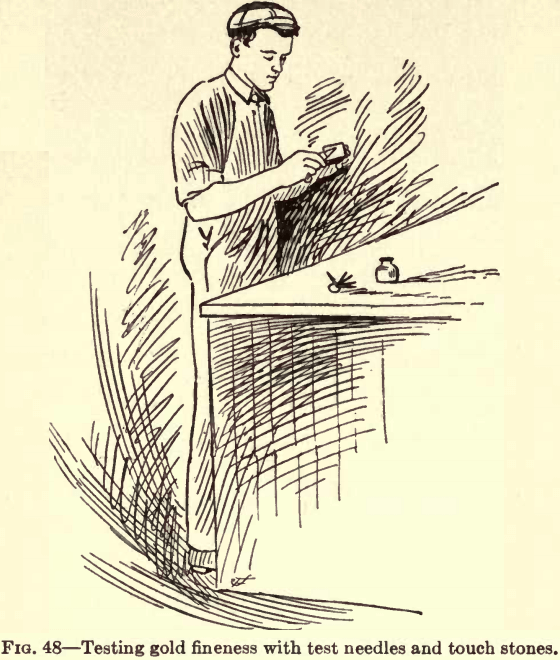Table of Contents
Description of Touch Stone and Test Needles
The touch or test stone is practically a small black whetstone. Test needles (Fig. 47) are a number of slim pointed brass fingers, one end having gold points of different fineness expressed in karats (the karat is the jeweler’s standard of measure for gold, and 24 karats is pure gold). The test needles range from a 2 karat point up to a 20 karat point, advancing 2 karats at a time. Six karat gold would be 6 /24 pure, 8 karat gold would be 8/24 pure gold, etc.
Method of Using
What is termed a streak is made on the stone by rubbing the gold (Fig. 48) to be treated across it, which leaves a narrow streak of the metal ground off upon the surface of the stone. This infinitely thin streak is made up of the gold and whatever alloy is with the gold. Then draw across both streaks a wet glass stopper from a bottle containing chemically pure nitric acid.
The test, which is to find approximately the karat of the gold, is based upon the fact that the nitric acid used in testing dissolves the alloy in the streak and leaves the gold untouched. The test is comparative and colorimetric. Comparative, because compared with a second streak of known fineness made from such of the test needles as is assumed to be nearest the fineness of the gold being tested. Colorimetric, because after applying chemically pure nitric acid to both

streaks simultaneously, a comparison may be made between the color of the two streaks. The one having the most color or showing the greater amount of gold after the alloy is dissolved out of the streak by the acid, is the finer.
If the gold tested shows a stronger streak than the needle streak, it is evident the gold was finer than the needle, and a still finer needle may be tried against it.
When no difference between the streak of the gold tested and that of the needle is discernible, it is safe to assume that the gold is of approximately the same karat as the needle whose fineness is a known quan-

tity. In making streaks for comparison, endeavor to grind on to the stone an equal amount from the needle and the object tested. Should any doubt exist as to which streak is the finer after having applied the nitric acid, dip a wooden toothpick or splinter into some hydrochloric acid and rub the moistened end of the splinter across the two streaks where the nitric acid was applied. The poorer streak will disappear first, as aqua regia was formed by the mixing of the acid on the splinter and the nitric acid on the streaks, and naturally the streak having the least gold left in it will disappear first as aqua regia readily dissolves gold.
Accuracy Possible
Practice and care in manipulation will soon enable one to estimate within .050 the fineness of gold tested in this manner. A touch stone and alloyed needles are very convenient adjuncts to a laboratory, as by their use preliminary to making a bullion assay, an approximate idea of the fineness of bullion to be assayed may be had, which will allow the assayer to properly alloy his bullion assays for partition.
